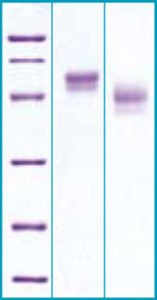Soluble Advanced Glycation End Product-Specific Receptor Human HEK293
The receptor for advanced glycation end products (RAGE) is a multiligand member of the immunoglobulin superfamily of cell surface molecules. It mediates interactions of advanced glycation end products (AGE), the products of nonenzymatic glycoxidation of proteins/lipids that accumulate in the plasma and tissues of patients with diabetes.
Research topic
Diabetology – Other Relevant Products, Neural tissue markers, Renal disease
Type
Recombinant
Description
Total 331 AA, MW: 35.2 kDa (calculated). C-terminal Flag-tag 11 AA (highlighted).
Source
HEK293
Purity
Purity as determined by densitometric image analysis: >95%
SDS-PAGE Gel
12% SDS-PAGE separation of Human sRAGE
1. MW marker – 14, 21, 31, 45, 66, 97 kDa
2. reduced and heated sample, 2.5 μg / lane
3. nonreduced and nonheated sample, 2.5 μg / lane

Endotoxin
< 1.0 EU/ug
Formulation
Filtered (0.4 μm) and lyophilized from 0.5 mg/mL in 20 mM Tris, 50 mM NaCl, pH 7.5
Reconstitution
Add deionized water to prepare a working stock solution of approximately 0.5 mg/ml and let the lyophilized pellet dissolve completely. Filter sterilize your culture media/working solutions containing this non-sterile product before using in cell culture.
Applications
Western blotting, ELISA, Cell culture and/or animal studies
Shipping
At ambient temperature. Upon receipt, store the product at the temperature recommended below.
Storage/Expiration
Store the lyophilized protein at –80 °C. Lyophilized protein remains stable until the expiry date when stored at –80 °C. Aliquot reconstituted protein to avoid repeated freezing/thawing cycles and store at –80 °C for long term storage. Reconstituted protein can be stored at 4 °C for a week.
Quality Control Test
BCA to determine quantity of the protein.
SDS PAGE to determine purity of the protein.
LAL to determine quantity of endotoxin.
– Deane R, Singh I, Sagare AP, Bell RD, Ross NT, LaRue B, Love R, Perry S, Paquette N, Deane RJ, Thiyagarajan M, Zarcone T, Fritz G, Friedman AE, Miller BL, Zlokovic BV. A multimodal RAGE-specific inhibitor reduces amyloid beta-mediated brain disorder in a mouse model of Alzheimer disease. J Clin Invest. 2012 Apr 2;122 (4):1377-92
– Van Crombruggen K, Holtappels G, De Ruyck N, Derycke L, Tomassen P, Bachert C. RAGE processing in chronic airway conditions: involvement of Staphylococcus aureus and ECP. J Allergy Clin Immunol. 2012 Jun;129 (6):1515-21.e8

